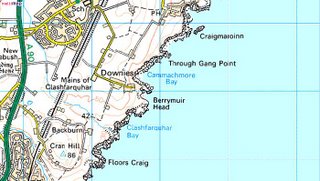
Having been partly developed by Tim Rankin but unreported, over the summer Tom Kirkpatrick has further developed this schist bouldering venue. It has larger boulders than Portlethen, meaning some highball finishes and problematic landings, as well as some deep-water soloing possibilities, but the best problems are safe and on good rock and there are some satisfying traverses. Tom will put a topo on the wiki at www.scottishclimbs.com
Tom's description:
Cammachmore Bay Bouldering
Chilled out bouldering venue, just south of Craigmaroinn. The Bay gets all the sun going and nesting puffins can be seen on the cliffs above and seals and porpoises in the water below. The climbing is on a variety of large and small blocs and walls on beautiful water washed schist. A good spread of grades is available. The only draw back is that mats and good spotters are definitely required.
The boulders can be approached in two ways. At very low tide by heading straight down the path towards the sea from the turning area at Downies, turning left at first col on the ridge to Gorillas Head, heading toward obvious ‘yellow headed’ boulder, then walking round the bay past The Dark Side boulders to the main area. If not possible then follow costal path north briefly before heading straight down vague path in the centre of headwall of bay. Time 3-5 mins.